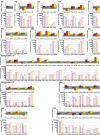Increased Butyrate Production in Clostridium saccharoperbutylacetonicum from Lignocellulose-Derived Sugars
- PMID: 35311509
- PMCID: PMC9004393
- DOI: 10.1128/aem.02419-21
Increased Butyrate Production in Clostridium saccharoperbutylacetonicum from Lignocellulose-Derived Sugars
Abstract
Butyrate is produced by chemical synthesis based on crude oil, produced by microbial fermentation, or extracted from animal fats (M. Dwidar, J.-Y. Park, R. J. Mitchell, and B.-I. Sang, The Scientific World Journal, 2012:471417, 2012, https://doi.org/10.1100/2012/471417). Butyrate production by anaerobic bacteria is highly favorable since waste or sustainable resources can be used as the substrates. For this purpose, the native hyper-butanol producer Clostridium saccharoperbutylacetonicum N1-4(HMT) was used as a chassis strain due to its broad substrate spectrum. BLASTp analysis of the predicted proteome of C. saccharoperbutylacetonicum N1-4(HMT) resulted in the identification of gene products potentially involved in acetone-butanol-ethanol (ABE) fermentation. Their participation in ABE fermentation was either confirmed or disproven by the parallel production of acids or solvents and the respective transcript levels obtained by transcriptome analysis of this strain. The genes encoding phosphotransacetylase (pta) and butyraldehyde dehydrogenase (bld) were deleted to reduce acetate and alcohol formation. The genes located in the butyryl-CoA synthesis (bcs) operon encoding crotonase, butyryl-CoA dehydrogenase with electron-transferring protein subunits α and β, and 3-hydroxybutyryl-CoA dehydrogenase were overexpressed to channel the flux further towards butyrate formation. Thereby, the native hyper-butanol producer C. saccharoperbutylacetonicum N1-4(HMT) was converted into the hyper-butyrate producer C. saccharoperbutylacetonicum ΔbldΔpta [pMTL83151_BCS_PbgaL]. The transcription pattern following deletion and overexpression was characterized by a second transcriptomic study, revealing partial compensation for the deletion. Furthermore, this strain was characterized in pH-controlled fermentations with either glucose or Excello, a substrate yielded from spruce biomass. Butyrate was the main product, with maximum butyrate concentrations of 11.7 g·L-1 and 14.3 g·L-1, respectively. Minimal amounts of by-products were detected. IMPORTANCE Platform chemicals such as butyrate are usually produced chemically from crude oil, resulting in the carry-over of harmful compounds. The selective production of butyrate using sustainable resources or waste without harmful by-products can be achieved by bacteria such as clostridia. The hyper-butanol producer Clostridium saccharoperbutylacetonicum N1-4(HMT) was converted into a hyper-butyrate producer. Butyrate production with very small amounts of by-products was established with glucose and the sustainable lignocellulosic sugar substrate Excello extracted from spruce biomass by the biorefinery Borregaard (Sarpsborg, Norway).
Keywords: Clostridium saccharoperbutylacetonicum; Excello; butyrate; fermentation; lignocellulosic sugars; metabolic engineering; solvents; transcriptome analysis.
Conflict of interest statement
The authors declare no conflict of interest.
Figures






Similar articles
-
Recent advances in n-butanol and butyrate production using engineered Clostridium tyrobutyricum.World J Microbiol Biotechnol. 2020 Aug 14;36(9):138. doi: 10.1007/s11274-020-02914-2. World J Microbiol Biotechnol. 2020. PMID: 32794091 Review.
-
Enhancement of acid re-assimilation and biosolvent production in Clostridium saccharoperbutylacetonicum through metabolic engineering for efficient biofuel production from lignocellulosic biomass.Bioresour Technol. 2019 Jun;281:217-225. doi: 10.1016/j.biortech.2019.02.096. Epub 2019 Feb 23. Bioresour Technol. 2019. PMID: 30822643
-
Development of a High-Efficiency Transformation Method and Implementation of Rational Metabolic Engineering for the Industrial Butanol Hyperproducer Clostridium saccharoperbutylacetonicum Strain N1-4.Appl Environ Microbiol. 2016 Dec 30;83(2):e02942-16. doi: 10.1128/AEM.02942-16. Print 2017 Jan 15. Appl Environ Microbiol. 2016. PMID: 27836845 Free PMC article.
-
Efficient butanol production without carbon catabolite repression from mixed sugars with Clostridium saccharoperbutylacetonicum N1-4.J Biosci Bioeng. 2013 Dec;116(6):716-21. doi: 10.1016/j.jbiosc.2013.05.030. Epub 2013 Jun 25. J Biosci Bioeng. 2013. PMID: 23809630
-
Microbial inhibitors: formation and effects on acetone-butanol-ethanol fermentation of lignocellulosic biomass.Appl Microbiol Biotechnol. 2014 Nov;98(22):9151-72. doi: 10.1007/s00253-014-6106-8. Epub 2014 Sep 30. Appl Microbiol Biotechnol. 2014. PMID: 25267161 Review.
Cited by
-
Modulation of sol mRNA expression by the long non-coding RNA Assolrna in Clostridium saccharoperbutylacetonicum affects solvent formation.Front Genet. 2022 Aug 11;13:966643. doi: 10.3389/fgene.2022.966643. eCollection 2022. Front Genet. 2022. PMID: 36035128 Free PMC article.
-
Simultaneous production of fatty acids and amino polysaccharides from Norway spruce hydrolysates using oleaginous Mucor circinelloides.Sci Rep. 2025 Apr 23;15(1):14106. doi: 10.1038/s41598-025-98549-0. Sci Rep. 2025. PMID: 40269125 Free PMC article.
References
-
- Grosse-Honebrink A, Little GT, Bean Z, Heldt D, Cornock RHM, Winzer K, Minton NP, Green E, Zhang Y. 2021. Development of Clostridium saccharoperbutylacetonicum as a whole cell biocatalyst for production of chirally pure (R)-1,3-butanediol. Front Bioeng Biotechnol 9:659895. 10.3389/fbioe.2021.659895. - DOI - PMC - PubMed
-
- Nakayama S, Kosaka T, Hirakawa H, Matsuura K, Yoshino S, Furukawa K. 2008. Metabolic engineering for solvent productivity by downregulation of the hydrogenase gene cluster hupCBA in Clostridium saccharoperbutylacetonicum strain N1-4. Appl Microbiol Biotechnol 78:483–493. 10.1007/s00253-007-1323-z. - DOI - PubMed
Publication types
MeSH terms
Substances
Supplementary concepts
LinkOut - more resources
Full Text Sources
Molecular Biology Databases

